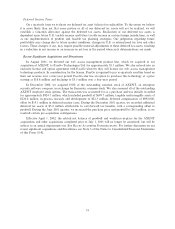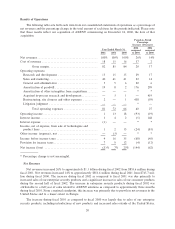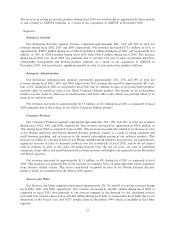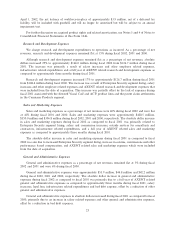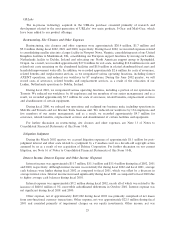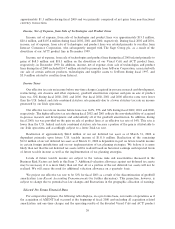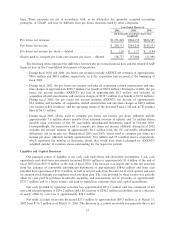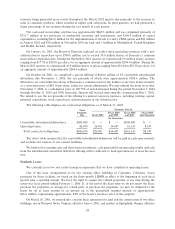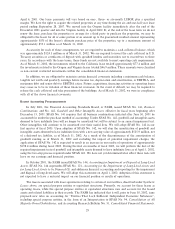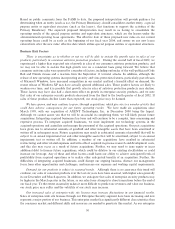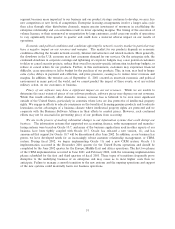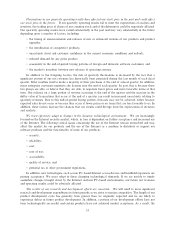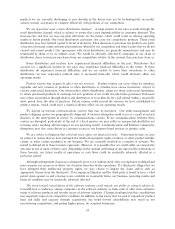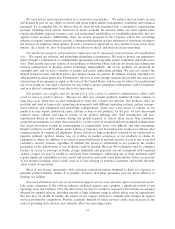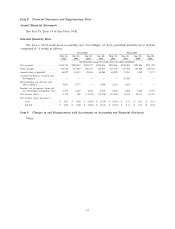Symantec 2002 Annual Report Download - page 51
Download and view the complete annual report
Please find page 51 of the 2002 Symantec annual report below. You can navigate through the pages in the report by either clicking on the pages listed below, or by using the keyword search tool below to find specific information within the annual report.April 6, 2001. Our lease payments will vary based on one-, three- or six-month LIBOR plus a speciÑed
margin. We have the right to acquire the related properties at any time during the six and one-half year lease
period ending September 28, 2007. We moved into the Oregon facility immediately after the end of the
December 2001 quarter and into the Virginia facility in April 2002. If, at the end of the lease term we do not
renew the lease, purchase the properties or arrange for a third party to purchase the properties, we may be
obligated to the lessor for all or some portion of an amount up to the guaranteed residual amount representing
approximately 85% of the lessor's ultimate purchase price of the properties, up to a maximum amount of
approximately $55.1 million as of March 31, 2002.
As security for each of these arrangements, we are required to maintain a cash collateral balance, which
was approximately $124.3 million as of March 31, 2002. We are required to invest the cash collateral in U.S.
Treasury securities or certiÑcates of deposit with speciÑed lenders and maturities not to exceed two to three
years. In accordance with the lease terms, these funds are not available to meet operating cash requirements.
As of March 31, 2002, the investments related to the California lease totaled approximately $77.4 million and
the investments related to the Oregon and Virginia leases totaled $46.9 million. These amounts were classiÑed
as non-current restricted investments within the consolidated Ñnancial statements.
In addition, we are obligated to maintain certain Ñnancial covenants including a minimum cash balance,
tangible net worth and quarterly earnings before income tax, depreciation and amortization, or EBITDA, and
maximum debt and senior debt to EBITDA ratios. Future acquisitions, Ñnancing activities or operating losses
may cause us to be in violation of these Ñnancial covenants. In the event of default, we may be required to
release the cash collateral and take possession of the buildings. As of March 31, 2002, we were in compliance
with all of the above Ñnancial covenants.
Recent Accounting Pronouncements
In July 2001, the Financial Accounting Standards Board, or FASB, issued SFAS No. 141, Business
Combinations, and No. 142, Goodwill and Other Intangible Assets, eÅective for Ñscal years beginning after
December 15, 2001. SFAS No. 141 requires that all business combinations initiated after June 30, 2001 be
accounted for under the purchase method of accounting. Under SFAS No. 142, goodwill and intangible assets
deemed to have indeÑnite lives will no longer be amortized but will be subject to an annual impairment test.
Other intangibles will continue to be amortized over their useful lives. We will adopt SFAS No. 142 in our
Ñrst quarter of Ñscal 2003. Upon adoption of SFAS No. 142, we will stop the amortization of goodwill and
intangible assets deemed to have indeÑnite lives with a net carrying value of approximately $525.9 million, net
of a deferred tax liability, as of March 31, 2002. As a result of the discontinuance of the amortization of
goodwill existing as of March 31, 2002 and excluding the impact of potential impairment charges, the
application of SFAS No. 142 is expected to result in an increase in our results of operations of approximately
$198.4 million during Ñscal 2003. During the Ñrst six months of Ñscal 2003, we will perform the Ñrst of the
required impairment tests of goodwill and intangible assets deemed to have indeÑnite lives as of April 1, 2002,
using the two-step process required under SFAS 142. We have not yet determined what eÅect these tests will
have on our earnings and Ñnancial position.
In October 2001, the FASB issued SFAS No. 144, Accounting for Impairment or Disposal of Long-Lived
Assets. SFAS No. 144 supersedes SFAS No. 121, Accounting for the Impairment of Long-Lived Assets and
for Long-Lived Assets to be Disposed Of, and addresses Ñnancial accounting and reporting for the impairment
and disposal of long-lived assets. We will adopt this statement on April 1, 2002. Adoption of this statement is
not expected to have a material impact on our Ñnancial position or results of operations.
The lessors associated with lease agreements relating to certain of our facilities, described under Synthetic
Leases above, are special purpose entities or equivalent structures. Presently, we account for these leases as
operating leases, while the special purpose entities or equivalent structures own and account for the leased
assets and related liabilities in their records. The FASB has indicated that it will, prior to June 30, 2002, issue
proposed new rules on accounting for ""Entities That Lack SuÇcient Independent Economic Substance'',
including special purpose entities, in the form of an Interpretation to SFAS No. 94, Consolidation of All
Majority-Owned Subsidiaries, and Accounting Research Bulletin No. 51, Consolidated Financial Statements.
29


